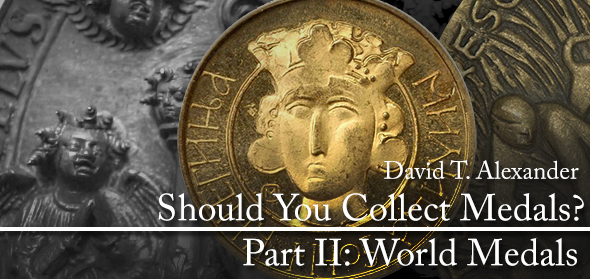
By David Thomason Alexander – Founder, Medal Collectors of America for CoinWeek….
As the first part of this review demonstrated, medal collecting in the United States is a growing field, charting solid gains after nearly two centuries of neglect. Success in medal collecting was shown to result from basic research, careful preparation, familiarity with existing literature and specialization in carefully chosen interest areas.
U.S. medals offer marvelous complexity, but world medals have been issued over seven centuries and offer vastly greater challenges and opportunities to aspiring collectors. Such collectors must come to terms with the broad sweep of history, the changing borders and geography of the past, and the significant reality of varied languages in which medals may be inscribed.
Some authors trace the beginnings of the modern medal to mysterious pieces known to have been part of the collection of French nobleman Jean, Duke of Berry around 1401. Created by a skilled but unidentified artist, two of these portrayed Roman Emperors Constantine the Great and Heraclius, rescuer of the True Cross.
 Many students of medal history believe that the first identifiable modern medal is the portrait piece of Eastern Roman Emperor John VIII Palaeologus, cast in 1438-1439 by Antonio Pisano, called Pisanello (circa 1380-1455). This talented artist began his career as a painter and long after launching his career as a medallic sculptor still signed his work OPVS PISANI PICTORIS, Work of Pisani the Painter.
Many students of medal history believe that the first identifiable modern medal is the portrait piece of Eastern Roman Emperor John VIII Palaeologus, cast in 1438-1439 by Antonio Pisano, called Pisanello (circa 1380-1455). This talented artist began his career as a painter and long after launching his career as a medallic sculptor still signed his work OPVS PISANI PICTORIS, Work of Pisani the Painter.
The emperor visited Italy seeking military help from the Pope and Christian powers for the last-ditch defense of his realm. John’s domains had been slowly nibbled away by Turkish conquerors until little more than the real estate surrounding Constantinople was left. He and the Pope agreed to the reunification of the Latin and Greek churches as part of the attempted rescue.
Pisanello was fascinated by everything associated with John’s visit, his features, clothing, headgear, and the horse he rode upon. His medal inspired other sculptors to try their hand at the medal and in a few years, there were many skilled medalists hard at work, including such masters as Benvenuto Cellini, Matteo de’ Pasti, Sperandio, Leone Leoni, Giovanni Boldù, and many more.
Magnificent high-relief portraits glorified those honored. Unlike paintings, medals were durable and portable with reverses that could bear detailed scenes from Greek and Roman history and mythology, detailed views of castles and palaces and battle scenes. The reverses all contributed to doubling the potential for praise and honor of the issuer.
Nearly all Italian medals of this historic era are cast in Lead or bronze. Many were distributed as gifts of rulers, others were placed in the walls or under cornerstones of new buildings. All were intended to reflect the glory of their issuers, commemorate marriages and illustrious family members, celebrate victories on land and sea and record conquests.
The Renaissance medal moved over the Alps into the Germanic world and westward to the Netherlands. Highlighted by the work of the great Albrecht Dürer, German medalists began striking from steel dies to increase their output. Silver, finely grained stone and even hardwood were added to the list of medallic materials.
It should be emphasized that collecting Renaissance medals is not for the poorly informed or faint of heart. Careful examination of purported originals will reveal a distressing number of aftercasts of varying quality produced over the centuries. Many of these were made to deceive collectors, others for decorative uses such as wall décor, movie props or even coasters.
Fortunately, the last few decades have brought forward outstanding scholars and publication of long-needed studies that have clarified many long-enduring mysteries. A leader among these is medal savant Stephen K. Scher, master collector and researcher who edited The Currency of Fame: Portrait Medals of the Renaissance (Frick Collection, 1994) and Perspectives of the Renaissance Medal (American Numismatic Society and Garland Publishing, 2000).
Scher has published complex studies on identification of aftercasts based on meticulous measurement of diameters. Every cast made from an original medal will show measurable shrinkage and by charting this reduction in size an estimate of actual age can be made, though such work may not interest the casual collector.
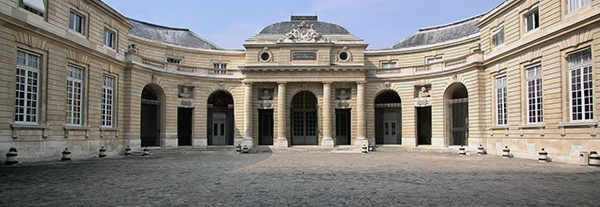
La Monnaie de Paris
France has occupied a leading position in the world of the medal since the Renaissance, including among its early designers and minters Guillaume Dupré (1576-1643) and Jean Warin (1596-1672). The Paris Mint, La Monnaie de Paris, has a longstanding policy of continuing to strike its medals for years and even centuries after they were first issued to the great confusion of starting collectors.
Beginning in 1977, the Mint published its Catalogue Général Illustré des Ėditions de la Monnaie de Paris (CGI). These are large 11½ x 8-inch paperback books illustrating and describing medals from the Renaissance down to the 1980s that are still produced by the Mint. Three volumes covered earliest times down to 1940; a fourth volume of three separate parts brought the story from 1945 forward.
Among the most recognizable French historical medals likely to be encountered by beginning collectors are the seemingly endless series of suite medals issued during the long reign of King Louis XIV, often styled Louis le Grand on these pieces.
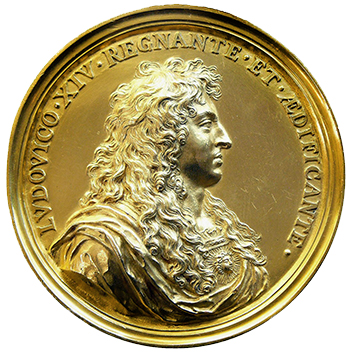 Louis determined that French medallic art should serve his glory and created the Academie des Inscriptions et Belles Lettres, often called the Petite Academie to rigidly control medal sculptors, designers and producers. Extensive series were created, comprising the Histoire Metallique de Louis le Grand.
Louis determined that French medallic art should serve his glory and created the Academie des Inscriptions et Belles Lettres, often called the Petite Academie to rigidly control medal sculptors, designers and producers. Extensive series were created, comprising the Histoire Metallique de Louis le Grand.
These uniform-size medals present more or less identical portrait obverses combined with languidly elegant but unexciting reverses featuring figures from ancient history and personifications that seem lifeless and repetitive to modern collectors. Interest in them as a result is minimal today.
A dramatic exception and a credit to collectors is provided by Louis XIV medals that present American subjects: victories in Canada and the West Indies that were listed by C. Wyllys Betts in his work on colonial history illustrated by medals.
In 2013, a long run of such American-interest Louis XIV medals from the celebrated collection of Boston collector John W. Adams appeared in an auction of the Dallas-based firm of Heritage. Cataloged by the author, this segment of the Adams collection contained a substantial number of Louis XIV pieces and realized some $990,000, a comment on specialized collector interest (Betts) and name recognition (Adams).
Special mention must be made of the Comitia Americana, American Congress medals struck in Paris for the infant United States. Beginning with the Washington before Boston medal, this short series hailed early American victories and heroic commanders. A wonderfully complex series, these medals have been restruck at Paris down to the present with many others struck at Philadelphia from copy dies.
Benjamin Franklin’s Libertas Americana medal dates from the same era, a magnificent propaganda design hailing the victories at Saratoga and Yorktown and hailing the French alliance. Born at the same time were the magnificent terra cotta B. Franklin Americaine medallions made by Jean-Baptiste Nini that were recently cataloged by medal scholar Richard Margolis in his definitive Benjamin Franklin in Terra Cotta.
The French Revolution initially freed French medalists from royal regimentation. Established engravers flourished, and such self-taught medalists as Pierre François Palloy, called “Palloy patriote” created relic medals made from scrap metal from the semi-abandoned fortress of the Bastille whose fall is still celebrated each July 14.
The new republic soon descended into the bloody anarchy of the Terror and a more or less permanent state of war with Britain and most of the rest of Europe. Out of this chaos emerged the medallic saga of Napoleon Bonaparte, who passed from poverty-stricken artillery cadet to youthful general and conqueror of much of Europe. He was then proclaimed first consul of the republic and finally emperor of the French.
Napoleonic medals display many of the puzzlements that traditionally deterred American coin collectors from entering the medal field, including such basics as accurate dating of medals in hand and determining value. Medals hailing Napoleon’s triumphs began to appear in the 1790’s and continued through his final military defeat in 1815.
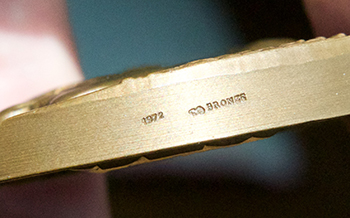
However, Napoleon never fully departed from the French medal scene. Many medals were struck in 1840 when citizen-King Louis Philippe staged the great Retour des Cendres, the epic stage-managed return of the Emperor’s body from the island of Saint Helena for entombment in the Invalides.
A major issue is determining just when a given medal was actually struck, understanding that dates appearing of the medals themselves seldom coincide with date of manufacture. Collectors must read all auction catalog descriptions very carefully. If there is no mention of edge markings including Paris Mint Privy Marks in a given description, do not assume that the date on the lot is accurate.
If these minute marks appear at all, they will be positioned on the rim near 6:00, along with metal designation such as OR, Gold; ARGENT, Silver, sometimes with added 1, 2 or 3; CUIVRE, Copper; BRONZE; or even ZINC.
Privy Marks provide an approximation of the date of striking through 1966. The tiny symbols include Lampe Antique (Antique Lamp), the first mark used on gold and silver only, March 1832-Oct. 1841; Ancre et C (Anchor and C), Oct.1841-Sept. 1842, used on copper, silver, gold; Prou Antique (Antique Prow), 1842-1845; Main Indicatrice (Pointing Hand), June 1845-Oct. 1860. Abeille (Bee), Nov. 1860-Dec. 1879; Corne d’Abondance (Cornucopia), Jan. 1, 1880 to present. After 1966 Paris added the actual date of striking to the rims.
Another mystery confronting collectors is the absence of a modern, comprehensive, illustrated and priced catalog of Napoleonic medals. CGI volume II devotes 84 pages to Napoleonic issues but the diligent collector soon discovers that the obverses listed may not match the piece in hand, and no medals are given estimated values!
The late Hans M.F. Schulman of New York used to take great joy in lacing his auction catalogs with obscure references to books he was sure none of his readers possessed and he was not alone in this.
Napoleonic collectors will find frequent auction references to “Bramsen.” These refer to the three-volume French-language Médallier Napoléon le Grand, ou Description des Médailles, Clichés, Repoussés et Décorations Relatives aux Affaires de la France pendant le Consulat et l’Empire, compiled by L. Bramsen, President of the Societé Numismatique of Copenhagen, Denmark.
The books were published by Alphonse Picard & Fils, Paris; and Gyldendalske Boghandel Nordisk Forlag, Copenhagen, printed by Imprimerie Holger Meyer, 1904-1913. Part I appeared in 1904; part II, 1907; part III, 1913. They present what is basically a glorified list with terse verbal descriptions, hundreds of pages without illustration, and of course no suggestions of values.
Collectors may also find references to famous auctions of the past that they probably also lack, named for collectors including Prince d’Essling, Montenuovo and Julius. Such catalogs have merit for identification despite their age but were not intended as definitive, objective catalogs of Napoleonic material.
Lacking a definitive reference catalog, the collector must rely of historical knowledge, ability to decipher symbols and the study of patinas and edge marks to discover what a medal actually is. Let’s dissect a Napoleonic medal with this in mind. A 68 millimeter piece dated Year XIII presents a high relief laureate bust facing left with Latin (not French) legend NEAPOLIO IMPERATOR, Napoleon Emperor. Below is a tiny signature GALLE FECIT, (André) Galle made it.
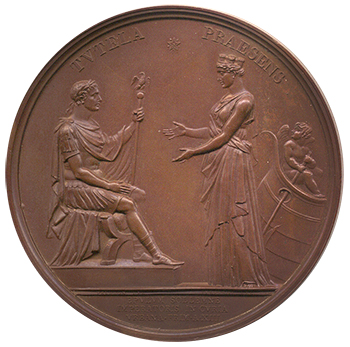 The reverse shows a seated figure of Napoleon as a Roman general, holding an eagle-crowned staff, greeting a standing mural-crowned woman who has just landed from an ancient ship at right. The crown identifies her as the city goddess of Paris and her ship is a feature of the city’s Arms. In exergue (below the figures) is inscribed EPVLVM SOLEMME IMPERATORIS IN CURIA VRBANA. FRIM. A. XIII, Solemn Banquet given the Emperor at the Hotel de Ville, Frimaire (revolutionary calendar) Year 13 (1804).
The reverse shows a seated figure of Napoleon as a Roman general, holding an eagle-crowned staff, greeting a standing mural-crowned woman who has just landed from an ancient ship at right. The crown identifies her as the city goddess of Paris and her ship is a feature of the city’s Arms. In exergue (below the figures) is inscribed EPVLVM SOLEMME IMPERATORIS IN CURIA VRBANA. FRIM. A. XIII, Solemn Banquet given the Emperor at the Hotel de Ville, Frimaire (revolutionary calendar) Year 13 (1804).
TVTELA PRAESENS, Personal Protection is inscribed above, Prudhon sketched it, (Romain-Vincent) Jeuffroy made it. Three examples of this medal were examined, the first displaying a smooth, deep chocolate patina with plain edge indicating a strike prior to 1841. The companion piece displays a brassy yellow patina used in the 1920’s, with edge inscribed Cornucopia BRONZE. The last is a fiery red-gold under fine lacquer with Cornucopia BRONZE and incuse striking date 1977.
Careful search reveals that this is Bramsen. 358. A skeptic might ask why the collector should bother studying this obscure data. For one thing, age can be a major determinant of market value and searching through U.S. and European auction catalogs for appearances of similarly marked Paris Banquet medals might indicate values of $350-450, $75-125 and $50-75 for these three variants.
As noted above, the sheer volume of new Paris Mint medals after World War II made it necessary to add three volumes for a CGI update. Modern art enthusiasts may admire some of the many bizarre and grotesque designs that emerged in the 1970’s but most Americans entering the field find them grotesque and their market value in the U.S. are really problematical.
Medals arrived in Britain as elsewhere when Renaissance art spread and then followed the general trends of the medal world. The first centuries of British medallic art are recorded in the magnificent 15 ¾ x 11 7/8-inch Medallic Illustrations of the History of Great Britain and Ireland, British Museum Publications, 1911, reprinted by Quarterman, Boston, 1979. This huge book provides a heavily illustrated panorama of British medals through the death of King George II in 1760.
Britain’s rich medallic history includes figures familiar to Americans from Henry VIII through Charles I, the Civil War and Cromwell, Restoration through the long reign of Queen Victoria. The ongoing medallic story from 1760 until the reign of Elizabeth II is recorded in Lawrence Brown’s richly illustrated modern-style three-volume British Historical Medals, first published by B.A. Seaby Ltd., completed by Spink and Son.
Modern British catalogers of real merit include Christopher Eimer and Daniel Fearon, whose books include values for a refreshing change. British medal historian and art chronicler Mark Jones enriched the whole world of the medal during his busy career his book The Art of the Medal and smaller offprints such as the Dance of Death devoted to medallic art of World War I.
There are great numbers of affordable medals from the reigns of George III and Victoria, but the medal as a commemorative item faded away in Britain and neither world war produced medals comparable to the proliferation of wartime German issues.
The 1970s saw a brief surge of Franklin Mint-style modern bullion-related private issues offered in Britain that are almost universally ignored today, much to the satisfaction of purists including cataloger Lawrence Brown. Modern medallic art, on the other hand, began a resurgence with the organization of the British Art Medal Society (BAMS) in recent decades.
The Germanic world of medals is every bit as complex as its age-old coinage history. Her role in the spread of Renaissance art was significant, with medals devoted to rulers, statesmen, city fathers, wealthy burgers and their wives. The rise of Martin Luther and the Reformation triggered a cataract of medals of contending imperial and Protestant leaders.
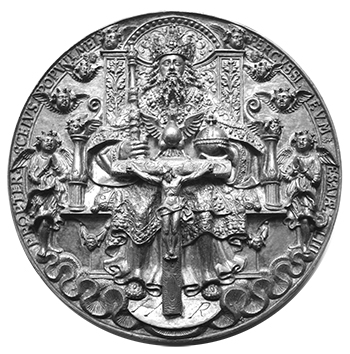 Among the most remarkable medals ever designed and cast was Hans Reinhard the Elder’s 103mm Dreifaltigkeitsmedaille or Holy Trinity Medal of 1544, made for Moritz, Duke of Saxony. Reinhard strove to show that the Catholic and Lutheran faiths were really reflections of each other and that concentration on what they held in common would restore Christian unity.
Among the most remarkable medals ever designed and cast was Hans Reinhard the Elder’s 103mm Dreifaltigkeitsmedaille or Holy Trinity Medal of 1544, made for Moritz, Duke of Saxony. Reinhard strove to show that the Catholic and Lutheran faiths were really reflections of each other and that concentration on what they held in common would restore Christian unity.
His medal attempted to depict the Three Persons of the Trinity: God the Father as a bearded ruler of the universe; the Holy Spirit as a Dove; Christ on the cross. An extensive Latin statement of this doctrine of worship of the Trinity would guarantee Christian unity.
As the centuries passed, hundreds of principalities, dukedoms, free cities, kingdoms issued medals and German medalists excelled at privately published satirical and propaganda issues. Another German specialty were “moralizing medals” devoted to holy scripture and the religious education of the young, medals of marriage and the sacraments.
Dealers seldom bother describing these later pieces individually and scores of types can still be purchased for low prices today. Finding out what they are requires obtaining obscure catalogs and references such as 270-page 1960 Karl Kress sale of The Marie Luise Goppl and other collections.
Goppl’s great attraction is its 72 plates depicting hundreds of medals that have perhaps never been illustrated elsewhere. This obscure book’s value for medal identification cannot be exaggerated.
German unification in 1871 saw changes in medal production. Prussia led in official medals under the empire. Distinctively German styles were developed in Bavaria by such talented Munich School medalists as Maximilian Dasio, Rudolf Bosselt, and many others.
All were swept up the First World War in 1914 and its chaotic aftermath. Artists like Ludwig Gies, Arnold Zadikow and above all Karl Goetz chronicled the global chaos brought by the war. Goetz’ medal justifying sinking of the RMS Lusitania was used against him and the fatherland with devastating effect by the British Admiralty.
Augsburg native Goetz continued using his distinctive art to protest perceived injustices to Germany in the post-war settlements, continuing down to the rise of Adolf Hitler, which the medalist opposed and into the Götterdammerung of the second world war. Brilliantly cataloged by Cleveland, Ohio cataloger Gunther Kienast, Goetz medals developed a solid and enduring following among American collectors.
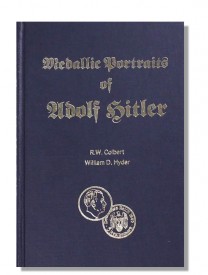 A somewhat unique addition to German medal cataloging was Medallic Portraits of Adolf Hitler, by R.W. Colbert and William D. Hyder, published by the Token and Medal Society (TAMS) in 1981. TAMS was, of course, the publisher of R.W. Julian’s master work on medals of the U.S. Mint. This small 160-page book was a major contribution to medal publishing but on a subject repellant to many in the TAMS membership.
A somewhat unique addition to German medal cataloging was Medallic Portraits of Adolf Hitler, by R.W. Colbert and William D. Hyder, published by the Token and Medal Society (TAMS) in 1981. TAMS was, of course, the publisher of R.W. Julian’s master work on medals of the U.S. Mint. This small 160-page book was a major contribution to medal publishing but on a subject repellant to many in the TAMS membership.
A proper study of medals of the Popes, Austria and the House of Habsburg, of Scandinavia, Switzerland, Poland, Spain and Portugal and their overseas successors would fill entire volumes. A few series like Swiss shooting medals have already received such thorough treatment.
Russian imperial medals finally have a modern reference in the several-volume Medals of the Russian Empire by Mikhail Diakov.
He includes study of Novodels or copies of early medals in addition to his exhaustive listing of originals from 1672 forward. Descriptions are best described as terse but the mass of information presented is invaluable.
Medals of modern Israel and Judaic medals are a well-charted field well covered by several modern catalogs. Israel state issues have been affected by the general subsidence that overtook Israel coins after 1973, but these medals display modern designs that are often of great beauty and are generally moderately priced today.
Medals of Latin America have been much neglected, with the possible exception of Mexican issues, but this part of the world field has light years to go before it reaches the levels that history and art should assure it.





What is that gold medal in the top picture with the author’s name? Is it Serbian writing?
Thanks, Jon
That little lady is the Gold Medal for the 600th Anniversary of the Accession of Milica Princess Consort, struck in gold in 1971.